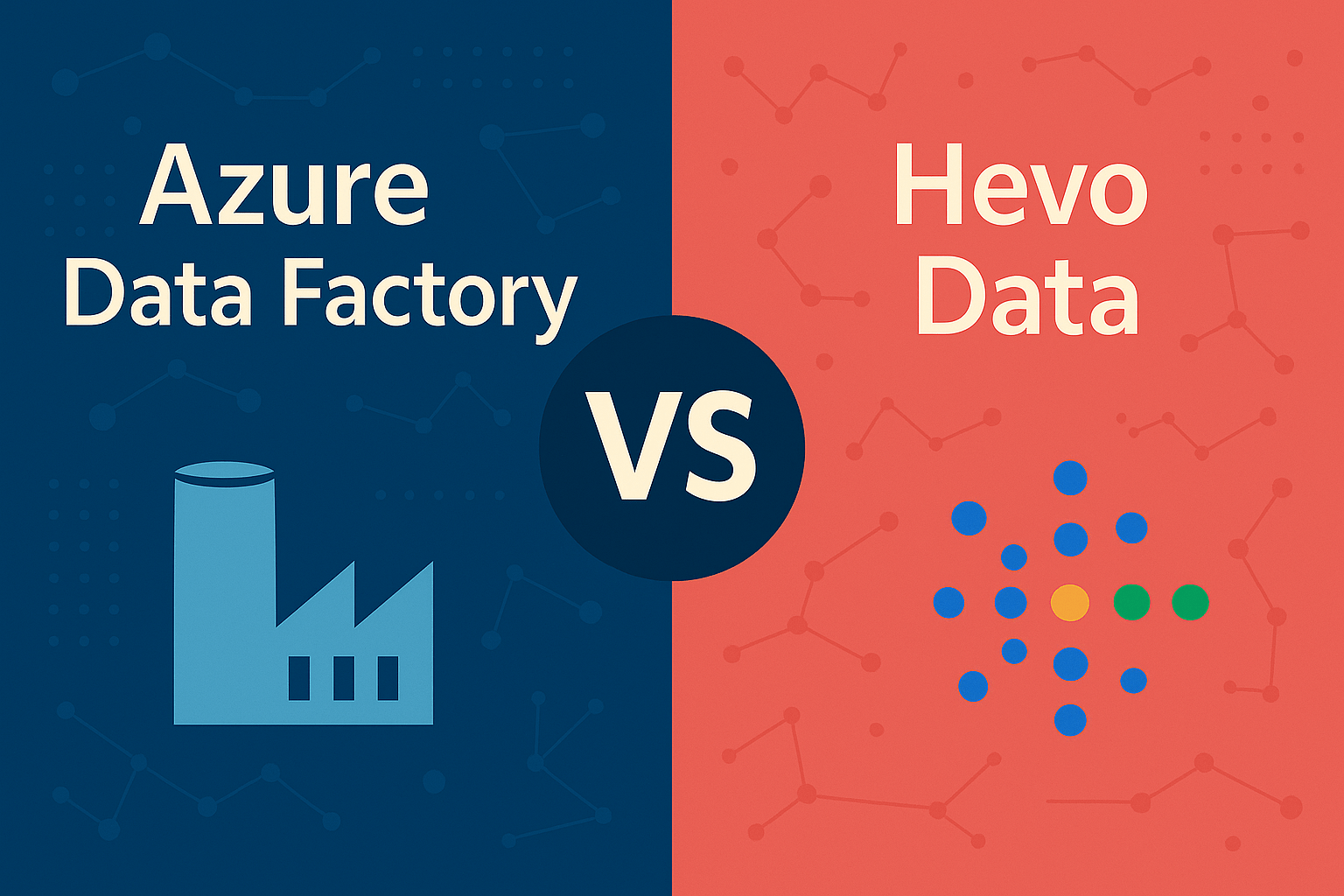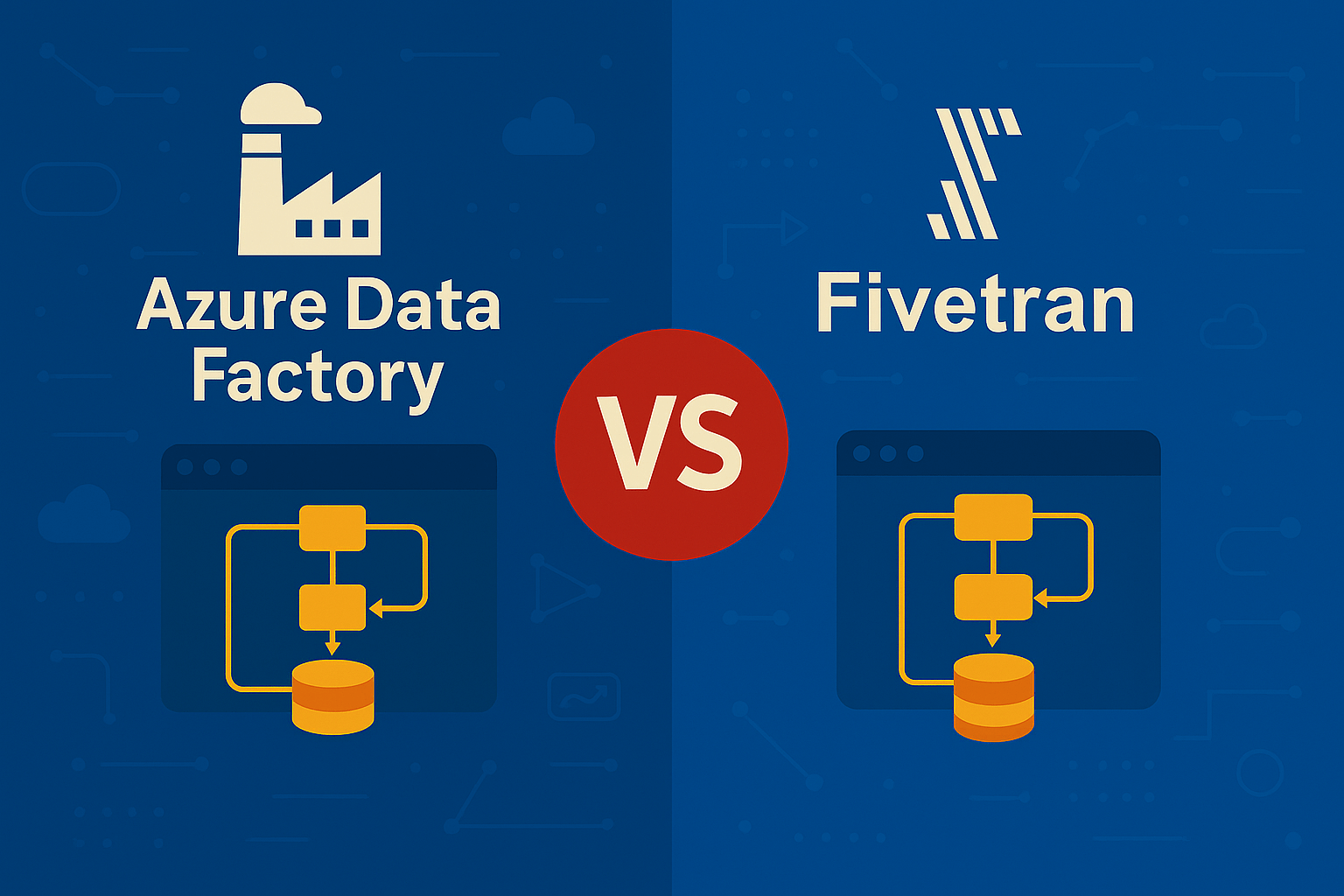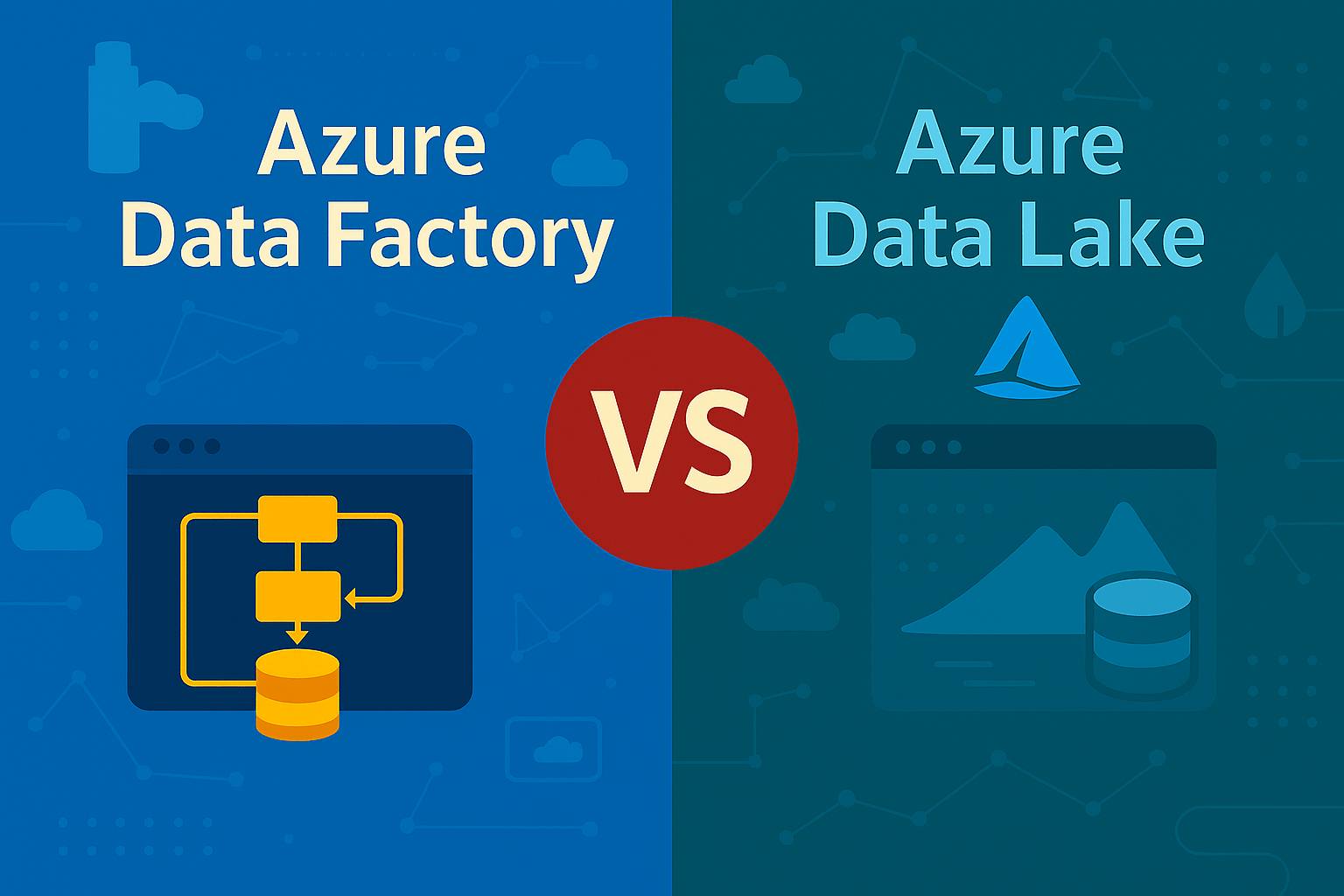Azure Data Factory vs. Databricks: Which Data Platform is Right for Your Analytics Needs?
Choose the Right Azure Data Platform for Maximum ROI
With over 180 zettabytes of data expected by 2025, choosing the right data platform has become critical for business success. Two of Microsoft’s most powerful data solutions—azure data factory and Azure Databricks—serve different but sometimes overlapping roles in modern data architectures.
Before diving deeper, it's important to understand the key features of both Azure Data Factory and Azure Databricks. Azure Data Factory offers robust data integration and orchestration tools, while Azure Databricks provides advanced analytics and machine learning capabilities built on Apache Spark.
Azure data factory excels as an orchestration powerhouse, offering drag and drop feature capabilities for data integration services across diverse sources. Meanwhile, azure databricks provides a unified analytics platform built on apache spark for advanced analytics and machine learning workflows. To perform complex data transformations, ADF can trigger Databricks notebooks for heavy-lifting tasks, combining the strengths of both platforms in a seamless workflow.
The key decision factors come down to your team’s technical expertise, use case complexity, and budget considerations. ADF shines when you need straightforward data movement and ETL workflows with minimal coding requirements. Databricks dominates when your organization requires real time data streaming, complex models, and collaborative data science environments.

There are key differences between Azure Data Factory and Azure Databricks in terms of architecture, functionality, and best use cases, which this article will explore in detail.
This comprehensive comparison will help you understand exactly when each platform excels, what real users are saying, and how to make the informed platform choice that maximizes your analytics ROI.
What Makes These Data Platforms Unique?
Azure Data Factory – Enterprise ETL Orchestration
Azure data factory adf serves as Microsoft’s cloud-native data integration service designed to simplify extract transform load processes across enterprise environments. The platform’s core strength lies in its graphical user interface that enables data engineers to maintain data pipelines visually without extensive coding. Azure Data Factory further streamlines the ETL pipeline process by allowing organizations to easily create, customize, and manage ETL workflows for a variety of data integration needs.
With over 90 pre-built connectors, ADF streamlines data movement between structured and unstructured data sources, from on premises databases to azure blob storage and other azure services. In addition, ADF enables users to build and manage ETL pipelines for diverse data integration and transformation scenarios. The platform handles large scale data movements efficiently through its integration runtime architecture, supporting both cloud-based and hybrid scenarios.
Key capabilities include mapping data flows for scalable data transformation, automated scheduling through comprehensive task dependencies, and seamless integration with the broader azure ecosystem. ADF’s low code interface makes it particularly valuable for organizations seeking to implement data orchestration workflows without requiring deep programming expertise from their teams.

The platform excels at coordinating complex data workflows that span multiple systems, offering robust monitoring and error handling capabilities. For enterprises needing reliable data integration across diverse environments, ADF provides the orchestration layer that keeps data pipelines running smoothly.
Azure Databricks – Unified Analytics Platform
Azure databricks represents a collaborative platform built on apache spark clusters, designed specifically for advanced analytics, machine learning, and real time data streaming scenarios. Databricks is a SaaS-based data engineering tool optimized for big data processing, offering unparalleled scalability and performance for demanding workloads. Unlike traditional ETL tools, Databricks offers a unified environment where data scientists, data engineers, and analysts can work together using notebooks supporting Python, R, Scala, and SQL.
The platform’s architecture centers on providing enterprise grade security while enabling teams to build machine learning models and perform big data analytics at scale. Unity Catalog serves as the metadata management layer, offering fine-grained access controls and data lineage tracking across large datasets. Databricks also supports BI reporting as part of its unified analytics platform, enabling integrated workflows for data science, machine learning, and business intelligence reporting.
Delta Lake integration brings acid transactions and versioning capabilities to data lakes, ensuring data reliability for both batch processing and streaming data workloads. This combination enables organizations to implement a data lakehouse architecture that supports both operational and analytical use cases.

For organizations requiring extensive coding flexibility and complex analytical capabilities, Databricks provides the processing power and collaborative tools needed for sophisticated data science workflows. The platform particularly excels when teams need to transform data through custom algorithms and build advanced analytics solutions.
Azure Data Factory vs. Databricks: Core Differences
|
Factor |
Azure Data Factory |
Azure Databricks |
|---|---|---|
|
Primary Purpose |
Data orchestration and movement |
Advanced analytics and machine learning |
|
Coding Requirements |
Low code interface with gui tools |
Extensive coding in Python, SQL, Scala, R |
|
Learning Curve |
Minimal technical expertise required |
Requires programming and Spark knowledge |
|
Data Processing |
Basic transformations, relies on external engines |
Native processing with apache spark |
|
Real-time Streaming |
Limited, requires other azure services |
Native streaming data support |
|
Cost Structure |
Pay-per-pipeline activity and data volume |
Pay-per-cluster usage and compute time |
|
Team Collaboration |
Pipeline sharing and version control |
Collaborative notebooks and workspace |
|
Data Governance |
Basic lineage, integrates with Azure Purview |
Advanced governance with Unity Catalog |
The fundamental difference lies in purpose and complexity. ADF functions as a data integration service focused on moving and basic transformation of data across systems, while Databricks serves as a comprehensive analytics platform for complex data processing tasks. Azure Data Factory does not support live streaming data while Databricks does, making the latter a better choice for real-time analytics and streaming scenarios.
Both adf solutions handle large data volumes effectively, but their approaches differ significantly. ADF abstracts complexity through visual design tools, making it accessible to teams without deep technical expertise. Databricks embraces complexity, providing the tools and flexibility needed for sophisticated analytical workloads.
Performance benchmarks show that ADF excels at orchestrating workflows across multiple azure data sources, while Databricks delivers superior performance for compute-intensive transformations and machine learning workloads. The choice often comes down to whether your primary need is data movement or advanced analytics.
Cost considerations vary significantly between platforms. ADF’s consumption-based pricing works well for periodic data movements, while Databricks’ cluster-based model can be more cost-effective for continuous analytical workloads when properly managed.
What Data Engineering Teams Say
Real-world feedback from data engineering teams reveals distinct patterns in platform satisfaction and use cases. Organizations implementing ADF consistently praise its rapid deployment capabilities and minimal maintenance overhead.
“We moved from on-premises SSIS to Azure Data Factory and reduced our deployment time from weeks to days,” reports a senior data engineer at a Fortune 500 retail company. “The drag and drop feature made it possible for our business analysts to build simple data flows without involving our development team.”
Teams using ADF highlight the platform’s reliability for bulk data operations and its integration with other azure services. The visual interface enables non-technical stakeholders to understand data workflows, improving collaboration between business and IT teams.

Databricks users emphasize different benefits, focusing on analytical power and collaborative capabilities. A data science team at a healthcare provider shared: “Databricks notebooks transformed how we work together. We can share models, validate results, and deploy to production within the same environment.”
Common praise for Databricks centers on its handling of large scale data processing and machine learning workflows. Teams appreciate the unified environment that eliminates the need to switch between different tools for data preparation, analysis, and model development.
However, users also note challenges. ADF teams sometimes struggle with complex transformations that require backend code, while Databricks teams report that the platform requires significant technical expertise and careful cost management to avoid unexpected expenses.
Real-World Applications
Azure Data Factory and Azure Databricks are powering real-world data solutions across industries, from finance and healthcare to retail and manufacturing. With Azure Data Factory, organizations can quickly build data pipelines to ingest and process IoT data, social media feeds, or financial transactions, all through a low-code interface and intuitive GUI tools. This accessibility allows teams with varying levels of technical expertise to design and manage data workflows, accelerating time to insight and reducing reliance on specialized developers.
Azure Databricks, meanwhile, is the engine behind advanced analytics, machine learning, and data science projects that require processing of large datasets. Its unified environment supports the entire analytics lifecycle, from data preparation to model deployment, and integrates seamlessly with cloud services like Azure SQL and Azure Storage. Both ADF and Databricks empower organizations to harness the power of big data, enabling smarter decision-making and driving competitive advantage. By combining scalable data integration with powerful analytics capabilities, these platforms help businesses unlock the full potential of their azure data assets.
Platform Requirements Overview
Understanding the prerequisites for each platform helps organizations prepare for successful implementations and avoid common deployment challenges.
Azure data factory requires an Azure subscription and basic understanding of data integration concepts. Teams need familiarity with data sources, transformation logic, and pipeline scheduling concepts. The platform’s low code interface means that extensive programming skills aren’t necessary, though understanding data flow principles remains important.
Technical prerequisites include proper networking configuration between azure data lake storage and source systems, appropriate security permissions for data access, and monitoring setup for pipeline performance tracking. Most organizations can implement ADF with existing IT staff after basic training.

Azure databricks demands more substantial technical preparation. Teams need proficiency in at least one supported programming language (Python, SQL, Scala, or R) and understanding of apache spark fundamentals. Data scientists familiar with writing code for data transformations adapt quickly, but teams accustomed to gui tools face a steeper learning curve.
Infrastructure requirements include properly sized spark clusters for expected workloads, integration with azure blob storage or azure data lake for data storage, and network configuration for secure data access. Organizations often invest in Spark training or hire experienced data engineers when adopting Databricks.
Both platforms require ongoing maintenance, though at different levels. ADF needs monitoring of pipeline performance and occasional connector updates, while Databricks requires cluster management, cost optimization, and keeping pace with Spark version updates and feature enhancements.
Connectors and Data Sources: Integrating with Your Data Ecosystem
A robust data analytics strategy depends on seamless integration with a wide variety of data sources. Azure Data Factory (ADF) stands out with its extensive library of pre-built connectors, enabling data engineers to quickly connect to Azure Blob Storage, Azure Data Lake Storage, Azure SQL Database, and many other sources. This flexibility allows organizations to build data pipelines that move and transform both structured and unstructured data, supporting everything from legacy on-premises systems to modern cloud-native applications. For organizations evaluating data integration solutions, it's vital to consider how different platforms like Denodo and Starburst address various integration and analytics needs.
ADF’s support for diverse data sources means you can orchestrate scalable data transformation across your entire data ecosystem, whether you’re working with relational databases, big data platforms, or file-based storage. The platform’s visual interface makes it easy to map data flows and integrate new sources as your business evolves, empowering data engineers and data scientists to focus on delivering insights rather than managing connectivity.
Azure Databricks, as a unified analytics platform, also offers strong integration capabilities. It connects seamlessly to Azure Data Lake Storage, Azure Blob Storage, and Azure Cosmos DB, providing a powerful environment for data scientists and engineers to access, analyze, and transform data from multiple sources. This connectivity is essential for building advanced data analytics solutions that leverage the full spectrum of your organization’s azure data assets. By supporting both structured and unstructured data, Azure Databricks enables teams to unlock new insights and drive innovation across the business.
Security and Compliance: Safeguarding Your Data Workflows
Security and compliance are foundational to any data integration strategy, and both Azure Data Factory and Azure Databricks deliver enterprise-grade protection for your data workflows. Azure Data Factory incorporates robust security features such as encryption at rest and in transit, granular authentication, and role-based access control to ensure that your data pipelines remain secure throughout their lifecycle. The platform’s verification successful waiting capabilities allow teams to monitor and validate data integrity at every stage, providing confidence in your data integration services.
Azure Databricks enhances security with advanced features like ACID transactions on Apache Spark clusters, ensuring that data processing is both reliable and consistent. The platform’s enterprise grade security framework includes fine-grained access controls and integration with Azure Active Directory, making it easy to manage permissions across large teams and complex projects. Both ADF and Databricks are designed to meet stringent regulatory requirements, including GDPR and HIPAA, so you can trust that your data integration and analytics workflows comply with industry standards. This commitment to security and compliance helps organizations protect sensitive azure data while enabling innovation and collaboration.
Azure Databricks and Collaboration: Empowering Teamwork in Analytics
Collaboration is at the heart of modern data analytics, and Azure Databricks is purpose-built to foster teamwork among data engineers, data scientists, and business analysts. The platform’s collaborative workspace allows teams to co-develop data pipelines, design ETL workflows, and build machine learning models within a unified environment. Shared notebooks, real-time commenting, and integrated version control streamline communication and accelerate project delivery.
Azure Databricks’ integration with other Azure services, such as Azure Active Directory and Azure Storage, further enhances the collaborative experience. Teams can securely access shared data, manage permissions, and leverage the full power of the Azure ecosystem without leaving the Databricks environment. This collaborative platform is especially valuable for organizations tackling big data analytics and complex models, as it enables seamless knowledge sharing and rapid iteration. By bringing together diverse skill sets in a single workspace, Azure Databricks empowers organizations to unlock deeper insights and drive business value from their data.
Data Lake and Storage: Managing and Scaling Your Data
Efficient data management and scalability are critical for organizations dealing with large data volumes. Azure Data Factory simplifies the process of moving and orchestrating data across various data lakes, including Azure Data Lake Storage and Azure Blob Storage. With ADF, you can design and automate data pipelines that ingest, transform, and distribute azure data across your storage landscape, ensuring that data is always available where it’s needed.
Azure Databricks takes data storage to the next level with its data lakehouse architecture, combining the scalability of data lakes with the reliability and performance of data warehouses. By leveraging Apache Spark clusters, Databricks enables high-performance processing of big data, supporting everything from batch analytics to real-time data streaming. This architecture is ideal for organizations that need to process and analyze massive datasets efficiently, providing the flexibility to scale storage and compute resources as business needs evolve. Together, Azure Data Factory and Azure Databricks offer a comprehensive solution for managing, processing, and scaling your data in the cloud.
Which Data Platform is Right for You?
Choose Azure Data Factory if you need:
Simple ETL orchestration with minimal coding requirements tops the list of scenarios where ADF excels. Organizations seeking to implement data pipelines quickly without extensive developer resources find ADF’s visual approach invaluable for creating and maintaining data workflows.
Quick deployment of data integration pipelines across multiple sources becomes straightforward with ADF’s extensive connector library. The platform handles data movement between diverse systems—from legacy databases to modern cloud services—without requiring custom integration development.

Non-technical teams benefit significantly from ADF’s graphical user interface. Business analysts and data engineers can collaborate on pipeline design using visual tools, reducing dependency on specialized programming skills while maintaining professional-grade data processing capabilities.
Cost-effective solutions for straightforward data movement make ADF attractive for organizations with budget constraints. The consumption-based pricing model means you pay only for actual pipeline activities, making it economical for periodic data integration tasks.
Strong integration with existing Microsoft ecosystem provides additional value for Office 365 and Azure-centric organizations. ADF naturally connects with azure sql, Azure Synapse, and other azure services, simplifying architecture decisions and reducing integration complexity.
Choose Azure Databricks if you need:
Advanced analytics, machine learning, and real time data streaming represent Databricks’ core strengths. Organizations building sophisticated analytical solutions require the computational power and flexibility that apache spark clusters provide through the Databricks platform.
Collaborative environments for data scientists and engineers become critical when teams need to share models, validate approaches, and iterate on complex algorithms. Databricks notebooks enable seamless collaboration while maintaining version control and reproducible results across team members.

Complex data transformations and custom algorithm development demand the programming flexibility that Databricks offers. When standard ETL transformations aren’t sufficient, teams can write custom processing logic in their preferred programming languages while leveraging Spark’s distributed computing capabilities.
Unified platforms for the entire data science lifecycle eliminate tool switching and data movement between systems. From data preparation through model training and deployment, Databricks provides integrated workflows that streamline the analytics process and reduce technical complexity.
High-performance computing for big data workloads and streaming analytics becomes essential for organizations processing large data volumes in real-time. Databricks’ optimized Spark implementation and auto-scaling capabilities handle demanding computational requirements while maintaining cost efficiency through proper cluster management.
The decision ultimately depends on your organization’s analytical maturity, technical capabilities, and specific use case requirements. Many enterprises successfully combine both platforms, using ADF for data orchestration and Databricks for advanced analytics within their comprehensive data architecture. Organizations may use Azure Data Factory for simple ETL tasks while opting for Databricks for advanced analytics and machine learning workflows, leveraging the unique strengths of each platform.
Factory Thread vs Azure Data Factory vs Databricks: Real-Time Data Access for Manufacturing
Azure Data Factory excels at orchestrating cloud pipelines. Databricks powers advanced analytics. But neither is built to unlock live, governed access to operational data on the shop floor—this is where Factory Thread wins.
Why manufacturers choose Factory Thread:
-
Built for OT+IT integration – Access MES, ERP, historians, and SCADA systems with no ETL delays
-
Low-code + real-time – Give engineers fast access to trusted data without full pipeline builds
-
Works in hybrid/air-gapped plants – Deploy on edge, cloud, or hybrid environments
-
Compliance-first – Masking, RBAC, audit logs, and approval flows come built-in
Factory Thread complements Azure’s cloud-native tools by solving the last-mile challenge of plant-floor data access and compliance.
Share this
You May Also Like
These Related Stories

Azure Data Factory vs Hevo Data: Which Data Integration Platform is Right for You?

Azure Data Factory vs Fivetran: Which Data Integration Platform is Right for You?



No Comments Yet
Let us know what you think